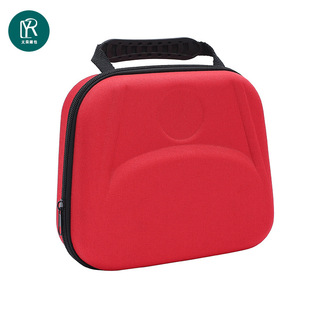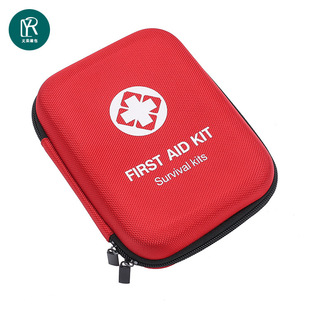Portable Medical Equipment EVA Bags: Meet Emergency Transport Standards, Safeguarding Life Safety
In the field of emergency medical care, “time is life” is more than just an empty slogan. From the accident scene to the ambulance, from the community clinic to the major hospital, every medical equipment transport is crucial to the patient’s treatment timeliness and life safety. Whether a portable medical equipment EVA bag, acting as a “mobile protective capsule” for medical equipment, meets emergency transport standards directly determines the stability, safety, and usability of the equipment during transport. Today, we’ll take a closer look at why portable medical equipment EVA bags that meet emergency transport standards are such a valuable aid for medical practitioners.
I. Emergency Transport Standards: The “Safety Red Line” of Medical Equipment Transport
Before understanding EVA bags, we first need to clarify: What exactly are emergency transport standards? It’s not just a vague concept; it’s a set of stringent standards developed jointly by international medical organizations (such as the WHO) and national health regulatory agencies (such as the US FDA and China’s National Medical Product Safety Administration). These standards cover multiple core aspects of equipment transport, including shock and drop resistance, waterproofing and moisture resistance, sterility protection, spatial adaptability, and portability.
Why are these standards called “safety red lines”? This stems from the unique nature of emergency medical care. Emergency medical care transports often involve complex environments: an ambulance hurtling through congested roads, medical staff running with equipment in hand through corridors, or even providing treatment outdoors in rainy and humid conditions. If the transport bag can’t withstand these external interferences, the accuracy of the medical equipment could be reduced (e.g., inaccurate data from a monitor) or even damaged (e.g., a broken syringe or a malfunctioning blood glucose meter), directly delaying treatment.
Take the internationally accepted EN 1789 emergency equipment transport standard as an example. It clearly requires that the transport container must be able to withstand a free drop test from a height of 1.2 meters, and the internal equipment must not have any functional damage; at the same time, it must have a waterproof capability of IPX4 or above, which can resist the intrusion of splashing water. The existence of these standards fundamentally avoids the potential risks in equipment transport.
II. EVA material: a “natural advantage carrier” that meets the standard
Why is EVA the preferred material that meets the emergency transport standard among many materials? This is inseparable from its unique material properties. EVA (ethylene-vinyl acetate copolymer) is a composite material with rubber elasticity and plastic processability. After special processing, it can perfectly adapt to the various requirements of the emergency transport standard.
(1) Super strong shockproof and anti-fall, protecting the equipment “unscathed”
The most common risks in emergency transport are collision and vibration, and the high-density foam structure of EVA material can form an efficient “buffer protection layer”. The interior of a high-quality EVA medical bag will adopt an integrated groove design, which precisely fits the shape of common medical equipment such as monitors, defibrillators, and infusion pumps. Combined with the 5-8mm thick EVA substrate on the outer layer, it can convert external impact force into elastic deformation and effectively absorb more than 90% of the vibration energy.
After third-party laboratory testing, the error value of precision medical equipment (such as a blood oximeter) placed inside the standard EVA medical bag in a 1.5-meter drop test was still controlled within 0.1%, which is far better than the protective effect of materials such as canvas and ordinary plastic.
(2) Waterproof and moisture-proof + antibacterial and antibacterial, building a solid “sterile defense line”
First aid scenes are often accompanied by pollutants such as body fluids, rainwater, and dust, and the airtightness and chemical stability of the EVA material can form a double protection. After the surface of the bag is treated with a waterproof coating, it can reach the IPX5 waterproof standard. Even if it is exposed to a short period of rain, the interior can remain dry. At the same time, the EVA material itself does not absorb water or mold. Combined with the internal detachable antibacterial lining (certified by ISO 22196 antibacterial test), it can effectively inhibit the growth of pathogenic bacteria such as Escherichia coli and Staphylococcus aureus, meeting the sterility requirements of emergency scenes. For drugs that need to be stored at low temperatures (such as insulin), some EVA medical bags will also be embedded with an insulation layer. When used with an ice pack, it can maintain a low temperature environment of 2-8℃ for more than 6 hours, meeting the transportation standards of special drugs. (3) Lightweight + flexible structure, adapted to “efficient transportation needs” Emergency transportation requires extremely high portability. Medical staff often need to carry the bag with one hand while performing other operations. The density of EVA material is only 0.93g/cm³, which is 30% lighter than a canvas bag of the same volume and 50% lighter than a plastic hard shell bag. For example, an EVA medical bag that can accommodate a small monitor weighs less than 1.2kg. Its widened and thickened shoulder straps significantly reduce the burden on medical personnel.
Furthermore, the EVA material’s high plasticity allows for customizable internal compartments and storage pockets based on the size and shape of different medical devices, achieving a precise “one device, one bag” fit. Details like quick-release buckles on the sides and a top handle also make accessing and placing equipment more efficient, fully meeting the “rapid response” standards required in emergency situations.
III. Standard-Compliant EVA Medical Bags: These Details Are “Indispensable”
Not all EVA medical bags meet emergency transport standards. A truly qualified product often demonstrates professionalism through meticulous attention to detail. When purchasing or using, you can focus on the following core details:
(1) Authoritative certification marks are “hard currency”
Standard EVA medical kits must have clear authoritative certification marks, such as the EU CE certification (in compliance with Medical Device Directive 93/42/EEC), the US FDA registration certificate, and the Chinese medical device packaging registration certificate. These certifications mean that the kit has undergone rigorous performance testing and quality audits, which is a direct guarantee of safety.
(2) The structural design needs to be “adapted to actual combat scenarios”
High-quality EVA medical kits will adopt “layered storage + visual design”: the outer layer can be used to place first aid supplies (such as bandages, cotton swabs), the middle layer can be used to store small equipment (such as stethoscopes, blood glucose meters), and the inner layer can be used to fix precision instruments; some kits will also use transparent PVC windows, so that the location of the internal equipment can be quickly confirmed without opening the kit, saving first aid time.
At the same time, the zipper of the bag body must be explosion-proof and can withstand more than 5,000 opening and closing tests; the connection between the shoulder strap and the bag body must be double-stitched + metal rivet reinforced to ensure that it will not fall off during long-term use. These details are all “hidden requirements” that meet the transportation standards.
(3) Durability is a “long-term test”
First aid equipment transport bags need to be used in complex environments for a long time, so durability is crucial. The surface of EVA medical bags that meet the standards will be treated with a wear-resistant coating and there will be no obvious scratches in 1,000 friction tests; the EVA base material of the bag body can still maintain elasticity in extreme temperature environments of -30℃ to 60℃, without cracking, hardening, etc., and can adapt to climatic conditions in different regions.
IV. More than “meeting the standards”: the “added value” of EVA medical bags
Meeting the emergency transportation standards is the “basic threshold” of EVA medical bags, and high-quality products can also bring more added value to medical practitioners. In primary healthcare settings, portable EVA medical bags can be used in conjunction with family doctor contracts, enabling “home delivery” of medical equipment. Medical staff can simply carry a matching EVA bag and equipment like blood pressure monitors and electrocardiograms to examine the elderly and patients with chronic conditions. The bag’s portability and protective features make primary healthcare services more efficient.
In disaster relief, batches of EVA medical bags can be quickly airdropped to disaster areas. Their shock-resistant and waterproof features ensure the equipment remains functional even in complex terrain, buying valuable time for rescue efforts.
In addition, some brands offer “personalized customization” services. Hospitals and emergency centers can engrave the bag with their organization’s logo, device name, and other information, facilitating device management and traceability, further standardizing medical transport.
V. Buying Guide: How to Choose an EVA Medical Bag That “Truely Meets Standards”?
With so many options on the market, how can you accurately select an EVA medical bag that meets emergency transport standards? Follow the “three checks and one test” principle:
Check certifications
Prioritize products with authoritative certifications such as CE, FDA, and NMPA, and reject those without them.
Check materials
Inquire about the density of the EVA base material (recommended: 0.95g/cm³ or higher), the thickness of the cushioning layer (minimum 5mm), and inspect additional protective features such as waterproof coatings and antimicrobial linings.
Check details
Inspect the quality of accessories such as zippers, straps, and buckles. Test the bag’s opening and closing for smoothness and comfort, and confirm that the internal compartments are compatible with the medical device you are using.
Test performance
If conditions permit, request a third-party laboratory test report, focusing on compliance with relevant standards for drop tests, waterproof tests, and antimicrobial tests.
Conclusion
The claim that portable medical device EVA bags “meet emergency transport standards” is not just a marketing slogan; it reflects a reverence and responsibility for life. Leveraging the inherent advantages of EVA material and adhering to stringent standards, this product, through meticulous design and quality control, serves as a “safety barrier” during the transport of medical equipment.
For medical practitioners, choosing a standard EVA medical bag is not only a safeguard for their work, but also a responsibility to their patients’ lives.
Post time: Sep-19-2025






